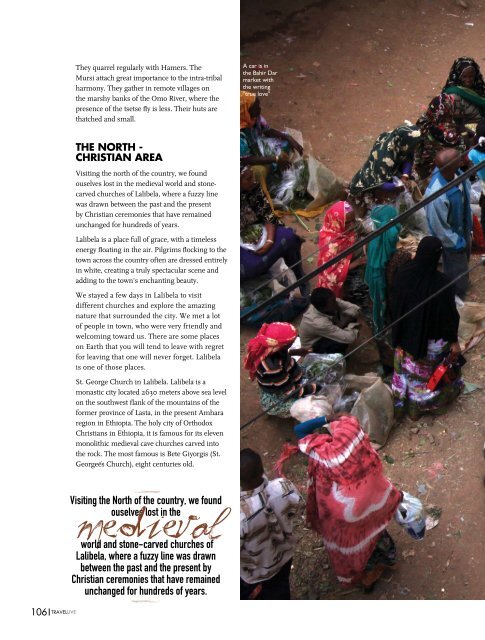TRAVELLIVE 3 - 2018
You also want an ePaper? Increase the reach of your titles
YUMPU automatically turns print PDFs into web optimized ePapers that Google loves.
They quarrel regularly with Hamers. The<br />
Mursi attach great importance to the intra-tribal<br />
harmony. They gather in remote villages on<br />
the marshy banks of the Omo River, where the<br />
presence of the tsetse fly is less. Their huts are<br />
thatched and small.<br />
The North -<br />
Christian area<br />
Visiting the north of the country, we found<br />
ouselves lost in the medieval world and stonecarved<br />
churches of Lalibela, where a fuzzy line<br />
was drawn between the past and the present<br />
by Christian ceremonies that have remained<br />
unchanged for hundreds of years.<br />
Lalibela is a place full of grace, with a timeless<br />
energy floating in the air. Pilgrims flocking to the<br />
town across the country often are dressed entirely<br />
in white, creating a truly spectacular scene and<br />
adding to the town's enchanting beauty.<br />
We stayed a few days in Lalibela to visit<br />
different churches and explore the amazing<br />
nature that surrounded the city. We met a lot<br />
of people in town, who were very friendly and<br />
welcoming toward us. There are some places<br />
on Earth that you will tend to leave with regret<br />
for leaving that one will never forget. Lalibela<br />
is one of those places.<br />
St. George Church in Lalibela. Lalibela is a<br />
monastic city located 2630 meters above sea level<br />
on the southwest flank of the mountains of the<br />
former province of Lasta, in the present Amhara<br />
region in Ethiopia. The holy city of Orthodox<br />
Christians in Ethiopia, it is famous for its eleven<br />
monolithic medieval cave churches carved into<br />
the rock. The most famous is Bete Giyorgis (St.<br />
George’s Church), eight centuries old.<br />
106<br />
<strong>TRAVELLIVE</strong><br />
Visiting the North of the country, we found<br />
ouselves lost in the<br />
medieval<br />
world and stone-carved churches of<br />
Lalibela, where a fuzzy line was drawn<br />
between the past and the present by<br />
Christian ceremonies that have remained<br />
unchanged for hundreds of years.















